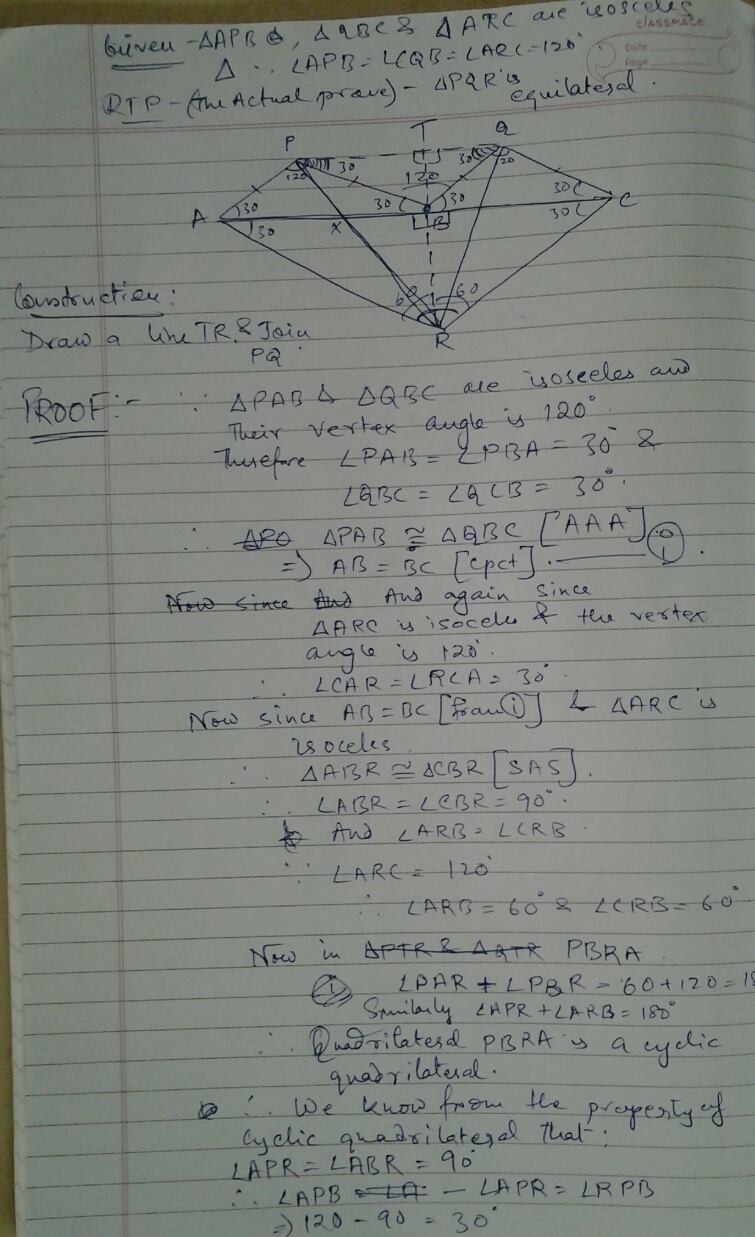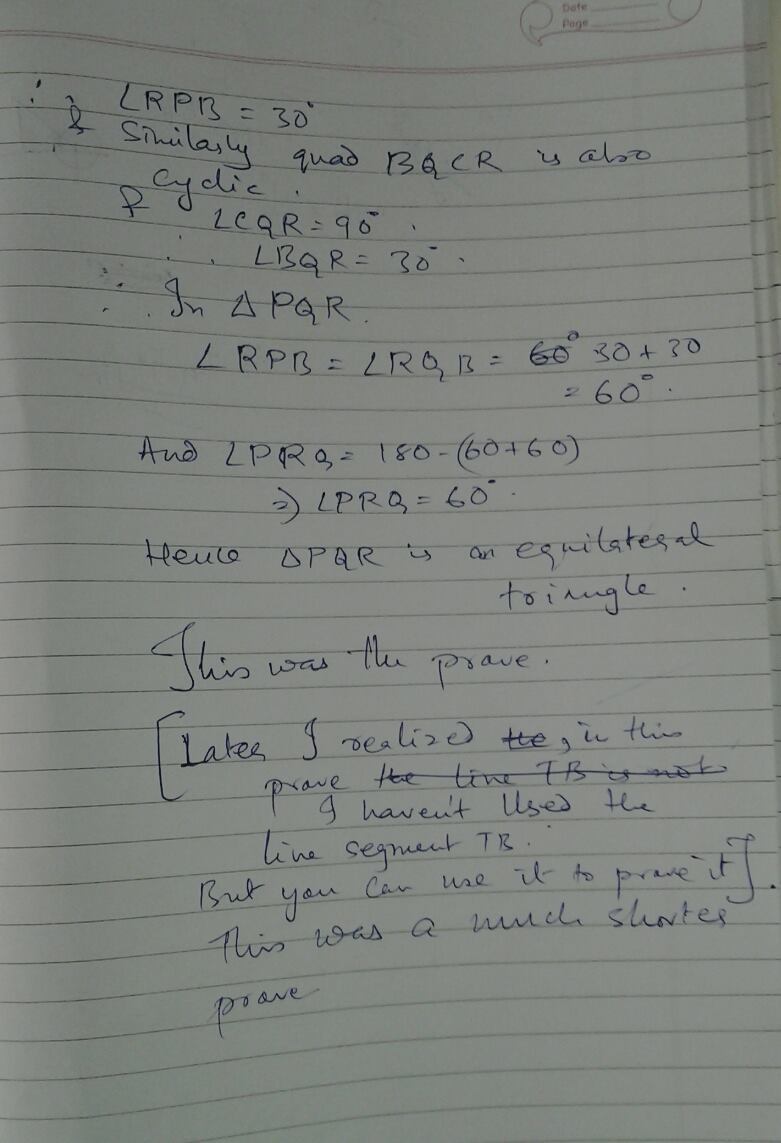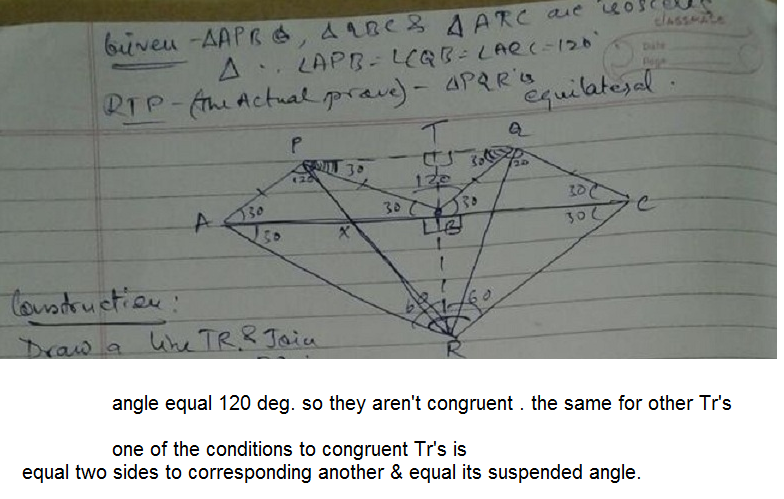Don't Just Guess, Try To Prove!
Let A C be a line segment in the plane and B a point between A and C . Construct an isosceles triangle P A B and Q B C on one side of the segment A C such that ∠ A P B = ∠ B Q C = 1 2 0 ∘ and an isosceles triangle R A C on the other side of A C such that ∠ A R C = 1 2 0 ∘ . Find the measure of ∠ P R Q in degrees.
This section requires Javascript.
You are seeing this because something didn't load right. We suggest you, (a) try
refreshing the page, (b) enabling javascript if it is disabled on your browser and,
finally, (c)
loading the
non-javascript version of this page
. We're sorry about the hassle.
3 solutions
Very nice. But how can you say those are rhombus? And according to the problem point B will be the midpoint of AC. Though your solution is very impresive. Thank you.
Log in to reply
BQ//MC , QC//BM & PQ=MC ---> CQPM is a parallelogram having equal its four sides.
then, CQPM is a Rhombus . similarly for APBM is a Rhombus.
Note that the problem don't state that point "B" is a midpoint of segment AC , but state that point "B" is between "A" & "C" . That is meaning that position of point "B" is a randum on segment AC not line AC.
Thanks.
Log in to reply
Yes it is not written than M is the midpoint. But those two triangles are congruent, and hence AB and BC are equal, which implies M is the midpoint.
Log in to reply
@Sattik Biswas – Sorry, the problem didn't stated that the two triangles APB , BQC are congruent.
Log in to reply
@Ahmad Saad – No it is not stated but I can prove it.
Log in to reply
@Sattik Biswas – I have proven it in my solution.
Log in to reply
@Sattik Biswas – My reply have been attached to my previous solution.
Triangle PAB and triangle QBC are congruent. By AAA criteria.
Log in to reply
Sorry, there isn't any thing to refere that in statment of problem or your proof.
You can present that to any mathematician or staff of this site.
Thank you for your solution. Could you please elaborate it.I mean it would have been nice if you could explain the steps. Thank you.
Moderator note:
This assumes that we are in the special case where B is the midpoint of AC, and doesn't constitute a rigorous solution.
Note that B is a point on AC, and not necessarily the midpoint of AC.
Log in to reply
Yes, but we can prove that.
Log in to reply
No, you are unable to prove that. B is any point on AC. E.g. B could be the point A (which leads to a degenerate case), but we still have ∠ P R Q = 6 0 ∘ .
If you assume it is the midpoint, you can find the numerical answer in this case. However, it doesn't represent a solution in all cases.
Log in to reply
@Calvin Lin – Got it. I am terribly sorry Calvin.


Relevant wiki: Similar Triangles - Problem Solving - Medium
Extend P B and Q B to meet C R and A R at points M and N respectively. Join Q M and P N .
A P B N and C Q B M are rhombus , each divided into two equilateral triangles.
Figure above shows that P N = P A = M R , Q M = Q C = N R and ∠ P N R = ∠ Q M R = 1 2 0 ∘ , then the two triangles P N R and R M Q are congruent,
then ∠ N R P + ∠ M R Q = 6 0 ∘ .
∠ P R Q = 1 2 0 ∘ − 6 0 ∘ = 6 0 ∘ .
In response to Mr. Sattik Biswas: